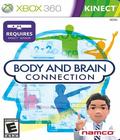Mention the name Dr. Kawashima to the average person in North America, and most people will look at you in bewilderment. Mention Brain Age, the game featuring the research by the doctor, and almost everyone will instantly recognize the title. Not only was it one of the first breakout hits for the Nintendo DS, but it was also the title that kicked off the brain games craze. With the release of the Kinect, Namco Bandai thought that it might have the ability to make lightning strike twice with the good doctor and created a game that promotes good brain activity combined with more physical hand-eye coordination. Unfortunately, due to some large technical issues, Body and Brain Connection is more of a flop than a hit.
Those who have played any brain game will quickly understand the concept behind this, but for the few who haven't, it is rather simple to comprehend. Your brain, like any other organ in your body, is susceptible to aging, and its performance can degrade over time. However, by giving it a consistent supply of mental exercises designed to help you think on your feet, you can keep your brain healthy. The big difference between this game and other brain games of its ilk is that you'll be using your whole body to answer questions instead of using a control pad or stylus; the aim is to get both physical and mental exercises instead of just one or the other exclusively.
The game features a few modes that are designed to either sharpen the brain or keep it fit. The Brain Fitness test is the most important, since it is the statistic that the game keeps track of every day. You can take three random exercises per day, and your performance at the end of those three tests yields your official brain age for the day. The age works in reverse of what you're normally used to, so the closer you are to 20, the better off your brain is. While you can take the exam multiple times a day, only the first score is counted. You can also take part in group mock tests, which have people competing for their own brain ages, though none of the results are officially counted in the stats.
Today's Exercises mode is similar to the Brain Fitness tests, minus the official brain age score at the end. You're given three exercises that are supposed to train your brain for the upcoming exams the next day. At the end of each exercise, you're given a letter grade for your performance and are encouraged to do them again for better scores.
Custom Exercises mode lets you select any game in any category with any difficulty level. There are five categories — Logic, Math, Memory, Physical and Reflexes — with four minigames apiece for a total of 20 games, and each of those games comes with three difficulty levels, two of which are unlocked after obtaining a good score at the end of a session. Each category places a good amount of emphasis on frontal lobe activity, and even though they all ask you to exert some physical effort to answer questions, don't expect it to be as strenuous as the Kinect's full-on exercise titles.
Finally, Group Exercises mode has you playing with up to three other people in a game show-like environment. Outside of the group brain challenge mode, it is one of the few multiplayer modes in Body and Brain Connection. Almost all of the minigames are more solo affairs than group ones, so it really is more of an observational multiplayer session than a simultaneously competitive or cooperative one. One aspect that makes it appealing, though, is the modifications in each minigame. Some involve additional noise that is meant to distract you while others have your view obscured by darkness or other characters walking by your playing field. If nothing else, it provides a nice change of pace for players who have gone through the activities multiple times in their normal configuration.
Like some of the better brain games on the market, the minigames are quite good. Not surprisingly, a good number of the minigames will be familiar to those who have previously dabbled in brain games. The new input method gives the minigames a fresh coat of paint so that they become enjoyable again. While the classic minigames are still pleasant, the newer ones provide the most fun simply because users were unable to do this type of thing before. The Pac-Man game, for example, requires you to manipulate both Pac-Man and either a Pooka from Dig Dug or a piece of fruit away from hungry ghosts. Another minigame asks you to shift directions to quickly determine if a set of numbers is below or above an indicated number. Another minigame asks you to use your arms to connect a bridge to get cars to their designated lanes. The physical games keep the title fresh and enjoyable even for veteran players of the genre, and they're a big reason for the game feeling just right.
Although the above description makes Body and Brain Connection sound like it has the perfect formula for pulling off a brain-training game on a console, it's the controls that make it suffer. The control mechanisms for each game are quite good. In all of the minigames, the title does a great job of following your hand and arm movements accurately and with no perceived lag. The same goes for the feet in games that require the user to kick, though the Step Mania game sometimes has issues in differentiating between a step and a jump.
Both the menus and face recognition work very well, but this is where the biggest caveat comes in. In a good lighting situation, such as in broad daylight or more controlled lighting, everything works perfectly. However, when the lighting is much dimmer, the menu control and facial recognition have an increased tendency for failure. While the minigames seem unaffected, navigating through menus is a much more difficult task because the act of selection often seems to lose focus. Signing into the game with less than optimal light also poses the problem of the game not recognizing you, forcing you back to the main menu until it does recognize you. Of all of the Kinect titles played thus far, from the poor ones like Sonic Free Riders and Fighters Uncaged to the marquee ones like Kinect Sports and Dance Central, Body and Brain Connection is the only one that seems to have trouble in anything but the best of lighting conditions. With the peripheral doing so well in a wide variety of titles, the issues become frustrating enough that players who aren't immediately discouraged will only play the game when the room is sufficiently illuminated.
The graphics aren't exactly indicative of the Xbox 360's capabilities, but they are sufficient. The environments look sterile, with completely white backgrounds that make any elements with color stand out much more than usual; this turns out to be very helpful in a good number of the tests. The game uses Xbox Avatars for its characters, and the developers did a good job of ensuring Dr. Kawashima is also done up in the same Avatar style, resulting in some great character animation. The simple style works out nicely, and it's a perfect fit for the game type.
While not all that important to the game, it is good to know that the title's sound is pretty good. Voices are minimal, and while it's odd to hear an English version of the doctor, the game doesn't use voices any more than it needs to, thus feeling more like a Nintendo-produced title. That feeling also comes through in the effects and the musical score, both of which are light and non-invasive to the rest of the game. Like the graphics, it's not the best, but it's good enough.
If it weren't for the control issues, Body and Brain Connection would be an instant recommendation to any Kinect owner. Most of the exercises are fun and challenging, and fans of brain games would instantly fall in love with the concept. However, the finicky nature of the controls for simple things like menu selection and starting the game suck the enjoyment out of the title. As a result, casual players, which are the game's target audience, will quickly lose interest. As it stands, the game can be considered a noble attempt with failed execution, and only those with a good amount of patience or excellent lighting should consider trying the game. Everyone else would be better off waiting for a sequel or a patch that irons out the game's technical issues.
Score: 6.5/10
More articles about Body and Brain Connection











 Body and Brain Connection challenges players to exercise both mind and body in the most cerebral and energetic party game ever from the originators of the video game brain training craze.
Body and Brain Connection challenges players to exercise both mind and body in the most cerebral and energetic party game ever from the originators of the video game brain training craze.

































